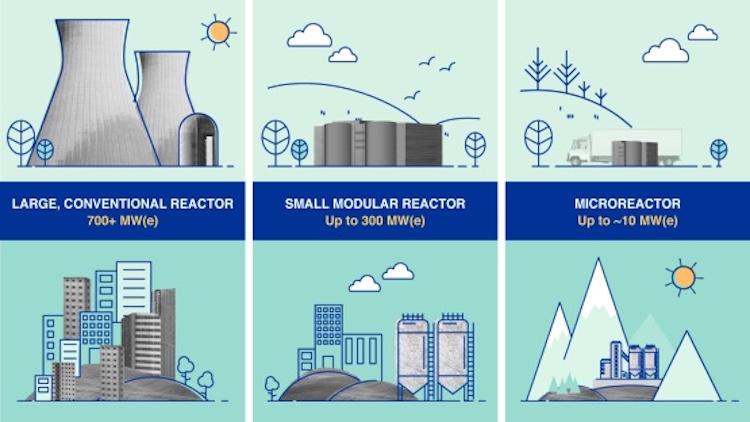By Leonam dos Santos Guimarâes
*The writer is a nuclear and naval engineer (Ph.D.) and a member of the Brazilian National Academy of Engineering. CEO of Eletronuclear S.A. Coordinator, Brazilian Navy Nuclear Propulsion Program.
RIO DE JANEIRO | 17 December 2023 (IDN) — The new generation of small modular reactors (SMR) is expected to provide greater safety, lower costs, easier financing, better compatibility with limited-sized national power grids, and reduced design risks, which could improve social acceptance and attract private investment.
Because of this, the nuclear community and even the mainstream media are increasingly turning to SMRs to herald a long-awaited but never observed “nuclear renaissance.” But this will not happen if SMR developers repeat the mistakes of the past. Over-promising on low costs is a major issue: remember the early claims that nuclear electricity would be “too cheap to measure”.
It has not yet been demonstrated that the economies of scale that have led to nuclear power plants becoming ever larger can be offset by the multiple economies that are expected from assembly line factory production, assuming that full order books can maintain these lines busy. But for how many of the more than 80 SMR projects in development will there be a market big enough to feed an assembly line for factory production? What would be the minimum order to make investment in the factory and its assembly line viable?
Already 50 years ago, physicists and engineers designing large nuclear power plants were focused on the interesting challenges of proposing more and more reactor variants that appeared, on paper, to be more efficient, safer or cheaper. But even the comparatively limited variety of designs proposed at that time proved to be more of a hindrance than an advantage.
The United Kingdom, for example, hesitated for years to make difficult choices while building and operating expensive, one-of-a-kind units of many different designs.
The most successful large reactor program occurred in France, where an early decision was made to restrict itself to a standardized PWR design. Today, the clear lesson is that only a few SMR projects can hope to benefit from the economics of multiples and thus achieve commercial success.
Another mistake from the past that also affects the economy is the long deadlines required for the implementation of nuclear power plants. Many of the delays are due to technical or project management deficiencies, but a major contributor has often been the time taken for regulators to license a new project.
Develop a set of “risk informed” regulations
The way to overcome this obstacle is to develop a set of “risk informed” regulations, tailored to smaller SMR projects, and then harmonize licensing regulations across all potential user countries. A useful precedent is the US Federal Aviation Administration, whose aircraft regulations are accepted globally as the technical basis for all national regulations.
But getting the economics of SMR right and reducing permitting and construction times will not alone solve the problem. There are other challenges that major reactor designers ignored until too late.
The clearest example here is the negligence in addressing the issue of safe disposal of spent fuel and/or high-activity radioactive waste. Even today, although final disposal facilities are being implemented in safe geological structures, for example in Finland, the “unsolved waste problem” is still presented by many as an objection to the expansion of nuclear energy.
SMR developers should, at the design stage, consider what waste will be produced and, at the selection stage, should offer specific help and advice to their potential customers, especially if these are small or new nuclear nations.
Nuclear proliferation and security concerns
In addition to these potential impediments to widespread SMR deployment, there are some new issues to be addressed. One of them is related to nuclear proliferation and the security concerns that may arise in a scenario in which hundreds of SMRs are distributed throughout the world, in many countries without nuclear experience and, in some cases, in remote regions within these countries.
In the end, due to their smaller fissile inventories than compact designs, nuclear safety concerns with widespread SMR deployment may be smaller than with current nuclear plants, with their much larger inventories of fissile materials. However, the issue must be discussed now by the nuclear community and not ignored until nuclear opponents in potential SMR user countries raise it as a deterrent.
If we are to learn from the bitter lessons of expected nuclear renaissances in the past, then we must learn from the mistakes made then and also anticipate any new and innovative issues that will arise with the widespread deployment of SMR.
It is also worth remembering that the nuclear renaissance expected in the first decade of the 21st century ended up not occurring mainly due to the Fukushima accident. Today the Zaporizhzhia plant has been severely threatened by the Ukrainian War. A severe accident could jeopardize all the efforts that have been made to ensure that the nuclear renaissance actually takes place in this third decade, driven by deep decarbonization combined with energy security. [IDN-InDepthNews]
Image: Small modular reactors (SMRs) have a power capacity of up to 300 MW(e) per unit. Many SMRs, which can be factory-assembled and transported to a location for installation, are envisioned for markets such as industrial applications or remote areas with limited grid capacity. Credit: A. Vargas | IAEA




